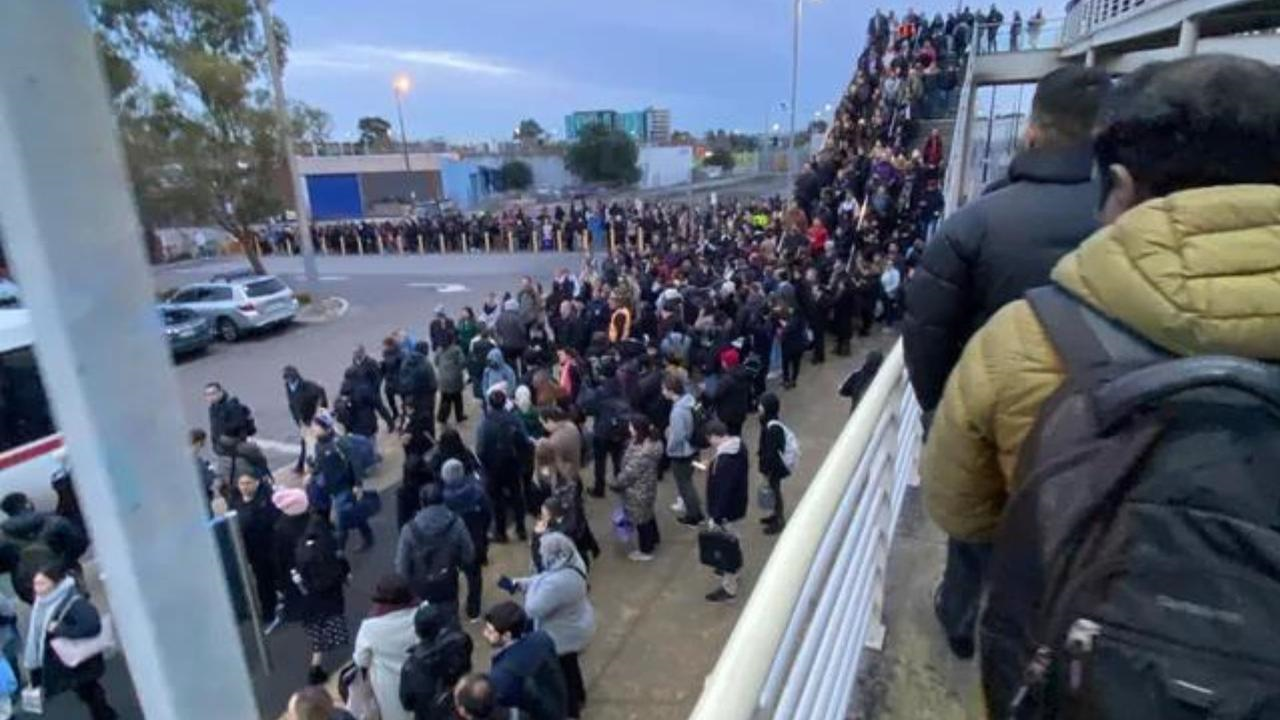Amid decades of extreme immigration, Melbourne’s population has swelled by an astounding 1.5 million people (+44%) in only 20 years:

As a consequence, Melbourne has been turned into a permanent construction site in a never-ending attempt to keep pace with the city’s unrelenting population expansion.
However, it never works, as traffic congestion, infrastructure bottlenecks, and liveability continue to worsen year after year.
To add insult to injury, the state government has rapidly sold-off public assets in order to fund further infrastructure spending.
Despite this, Victorians are drowning in state debt and paying ever-rising taxes and user fees:

Thousands of commuters were stranded for hours waiting for replacement buses on the Cranbourne line in June, highlighting Melbourne’s descent towards ponzi-fueled dystopia.
The photo below was taken on the second day of a two-week suspension of nine of the sixteen rail lines to allow for construction of the West Gate Tunnel Project:

Scores of commuters line up for replacement buses on the Cranbourne line.
The shutdown disrupted Melbourne’s transportation network, throwing both public transportation and road users into disarray.
The situation is worst for Melbourne’s far flung growth areas, which have experienced extraordinary population increases without the basic infrastructure to match.
Meet Melton: a former satellite city located 47 kilometres west from the Melbourne CBD.
On 17 April 2023, Melton was officially merged into the Melbourne Urban Area, making it part of Greater Melbourne.
The Melton council area has swelled in population from around 79,000 residents in 2006 to an estimated 205,000 this year as new suburbs and housing estates sprouted up.
According to the council, approximately 50 families move into the neighbourhood each week, and 50 kids are born, with the population predicted to reach 440,000 by 2051 – equivalent to Canberra’s current size.
The problem is, Melton does not have a public hospital, and plans to electrify its train line have fallen off the Victorian government’s priority list, leaving the area with fewer (and frequently overcrowded) public services and facilities.
Locals, both old and young, say the state government still treats Melton like it’s a small town where people move around on horseback.
“We’ve been banging our head against a brick wall but they don’t really seem to care”, GP Marcus Watson says.
Independent candidate Ian Birchall claims there has been a chronic shortage of infrastructure investment in Melton at both the state and federal levels.
“Anthony Albanese talks about western Sydney all the time, but you never hear about western Melbourne”, he says.
“To have no Tafe, no university, no hospital – we miss out on everything and it’s just not fair”.
Birchall says new housing estates keep springing up but with no amenities, “no pub or milk bar or service station”, so everyone has to go to the town centre. “If you go to the supermarket in Melton now the car park’s full. It’s crazy.”
“It’s just stupidity. They know the population is growing … it’s not like these problems have snuck up on them”, resident Daniel Molivas says of the government.
Melton’s demise is being replicated across Melbourne, whose population is expanding at a faster rate than housing, infrastructure and services.
Indeed, The Age on Monday reported that families in Altona Meadows are being forced into arduous commutes to send their kids to high school:
“Every year, families are zoned to high schools in surrounding suburbs including Laverton and Point Cook”.
“Parents face the difficult choice of a twice-daily, one-hour round trip along the congested Point Cook Road or M1 freeway, or sending their children on a quicker but arduous bike ride around the Cheetham Wetlands”.
The situation will only get worse given the May Federal Budget projected that Victoria’s population would grow by an unprecedented 694,000 residents over the five years to 2026-27:

Source: 2023 federal budget
Therefore, Victoria will gain the equivalent of 1.5 Canberra’s worth of population in only five years, which will obviously place extreme further pressure on housing and infrastructure.
Based on historical settlement patterns, around 500,000 of this population growth will land in Melbourne over the same five years.
Unbelievably, Victorian Premier Dan Andrews is actively lobbying Prime Minister Anthony Albanese for even more population growth.
Andrews told Italian-language newspaper Il Globo last month that “the new federal government have taken some important steps towards increasing the amount of permanent skilled migration, but I think they might need to do more again”.
“Prime minister Albanese knows this. I’ve spoken to him about it personally and part of it also is clearing the Visa backlog”, Andrews said.
However, at the same time as he is lobbying for more immigration into Victoria, Dan Andrews is actively cutting infrastructure investment into growth areas like Melton:
“Two new rail lines the Andrews government promised to build in Melbourne’s outer west have been axed, watering down an election commitment to deliver frequent Metro train services to some of the nation’s fastest-growing suburbs”.
“New electrified lines to Melton and Wyndham Vale were part of the “Western Rail Plan” Premier Daniel Andrews unveiled ahead of the 2018 election, with a promise to extend the metropolitan train network through the booming suburbs of Tarneit, Deer Park, Ardeer, Cobblebank, Rockbank and Caroline Springs”.
“[But] Rail Projects Victoria (RPV) has cut the new tracks from the Western Rail Plan”.
The Victorian government has failed badly to provide appropriate public housing, infrastructure, and services to the state’s rapidly swelling population.
Nonetheless, Premier Dan Andrews has demanded even more immigration while reducing infrastructure to the very areas most affected by rapid population expansion.
Labor’s irrational population fetish will transform once “Marvellous Melbourne” into an unliveable “Hellbourne”.
Nobody voted to have their living standards destroyed by Labor’s reckless mass immigration.

